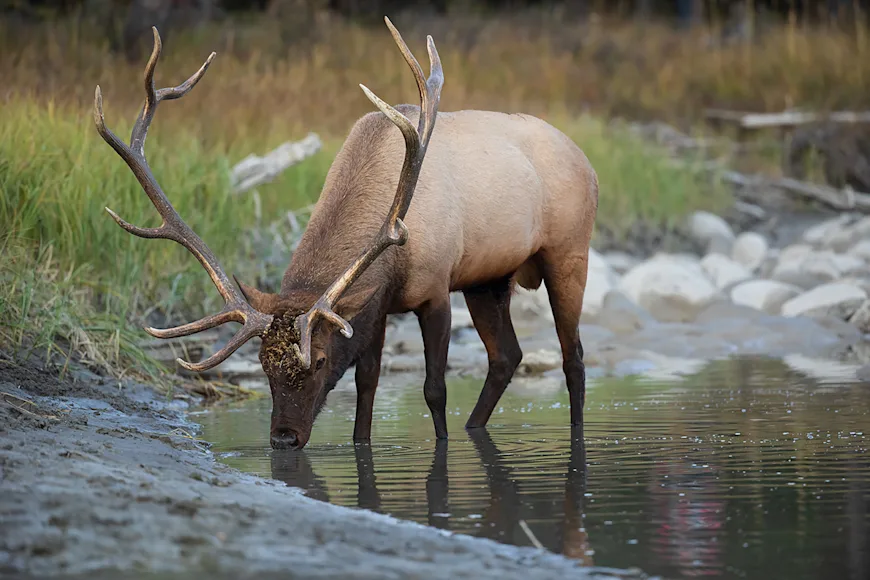An early morning hike found me two-thirds of the way up a timbered mountain. It was still dark, and I couldn't make my final approach until the air warmed and thermals began flowing uphill. Finally, the September winds shifted, and I side-hilled the last 300 yards. A series of cow calls got a bull bugling, below. Fifteen minutes later, a heavy rack tipped and swayed its way through the pines. When the bull’s blocky head went behind a skinny tree, I drew the bow and let out a sharp cow call with a diaphragm. The bull froze broadside.
The morning hunt was brief, but it took five days to figure out the elk in this area, which was new to me. One wallow and a series of rubs was what I used to help put the pieces together and punch my tag. These important signs can highlight crucial information about elk behavior, location, and patterns. You just need to know how to interpret what the wallows and rubs are telling you. Here are six things to look for the next time you come across an elk wallow or rub in the field.
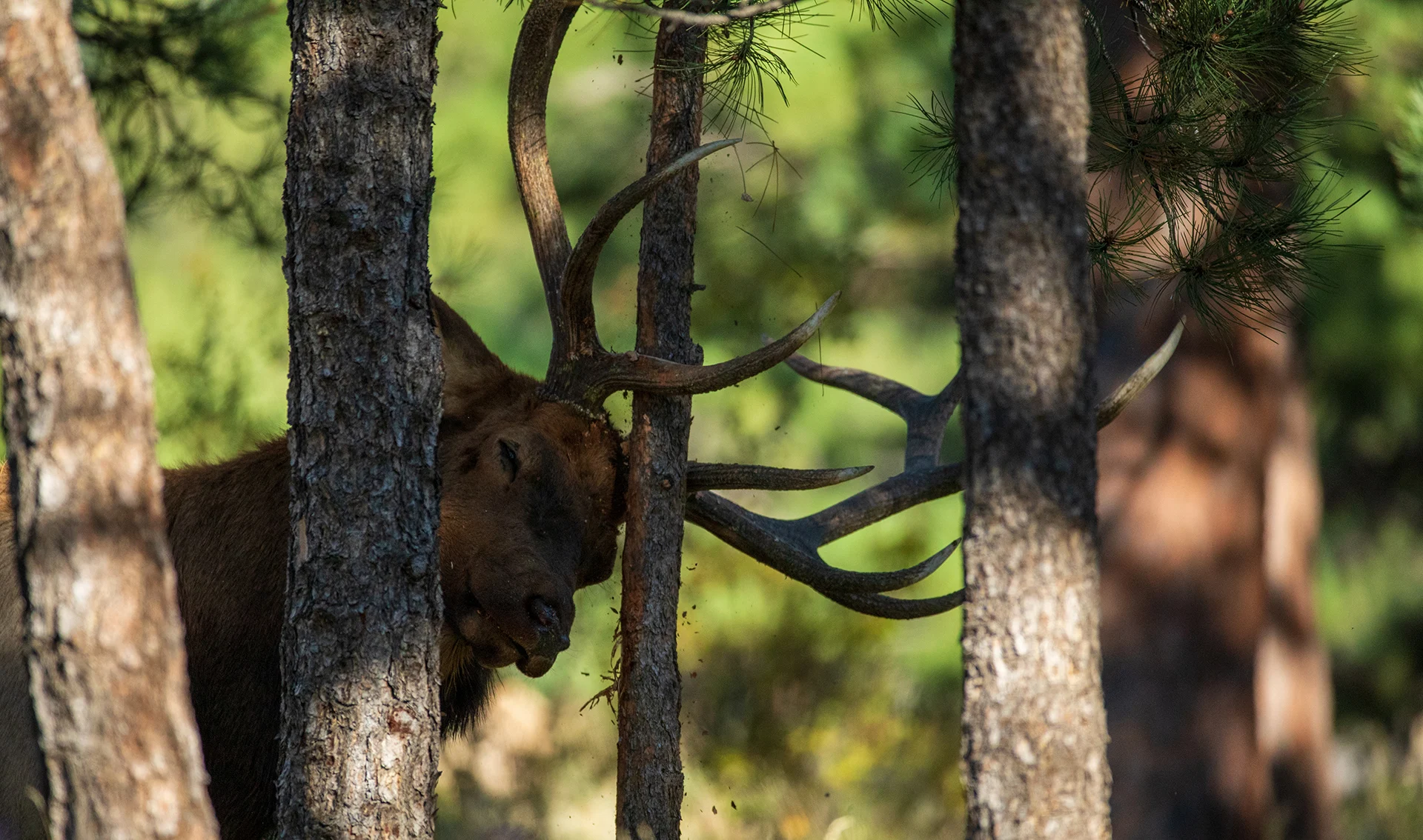
What Elk Wallows Tell You
Elk wallows are more than just a place where bulls roll around to spread their scent. Wallows are often used by multiple bulls, sometimes all day long. Last September, on a Moultrie Mobile trail camera set in the Coast Range for Roosevelt elk, I captured seven bulls using the same wallow throughout the day.
Sometimes a herd bull dominates a wallow. Sometimes young bulls hop in and out of a wallow. There’s never a given, and it’s continually changing throughout the various stages and intensities of the rut. That said, there are a couple of things to keep note of to help you pattern bulls.
Look for Water Flow
Over the decades, studying wallows has taught me a lot about elk behavior and elk hunting. When you find a wallow, don’t just look at it; inspect it thoroughly. The first thing to determine is whether or not the water is moving or stagnant. See if there’s a current flow that quickly whisks away sediment and any fresh sign. Do this by mucking up the water with your boot or a stick. Then watch the suspended sediment to see if it moves.
Some wallows with a steady current will run clear in a matter of minutes. Wallows with a rocky bottom filter water faster than those made in mud. When a bull rolls in a wallow with a good current flow, it might run clear in an hour or two. When hunters walk up to a clear wallow, it can fool them into thinking no bulls are near. If in doubt, pick up a handful of mud or dirt from a fresh track, specifically the soil that’s pushed up between the toes. If you can still smell the scent left by the interdigital gland, there’s likely a bull nearby.
Conversely, a muddy wallow with no current may have sediment suspended for days. This gives the illusion that a bull was just there, especially when the stench of a rutting bull hangs heavy in the air. A bull’s rutting musk can lay heavy in a wallow for days after it was there. I’ve muddied a stagnant wallow with my boot many times, only to circle back and find sediment still suspended two and three days later. Some wallows are used in passing by various bulls that can be miles away, despite what the wallows look and smell like. Don’t waste time hunting these areas. Instead, keep searching for details.
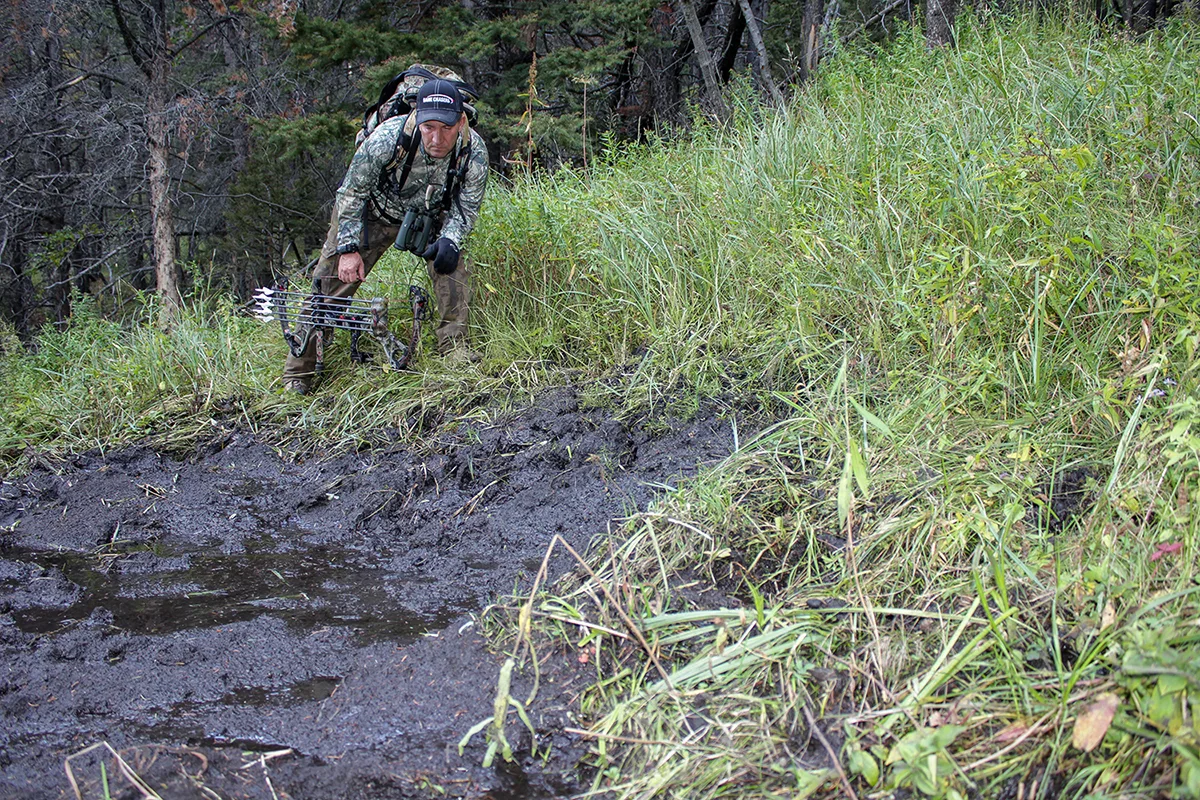
Mud On The Trail
Next, look for nearby trails and tracks and scour the area for wet splash marks. This reveals which direction bulls are leaving a wallow from, thus, where they’re going. Look closely at water droplets and splashes of mud that have fallen from bulls emerging from a wallow. You can tell by the angle of the splash which direction the bull is moving, even the rate at which it’s covering ground.
If the splash marks are round, the bull is moving slowly, maybe even standing still. This means the bull might be relaxing with a harem. Maybe they’re milling around, browsing, or slowly moving to a bedding area. Maybe it’s a lone bull methodically looking for cows. Perhaps it’s a young bull that’s had its tail kicked by a big bull. You can often catch up to these bulls.
If splash marks are at an angle, the bull is on the move. The more severe the angle of the splashes, the faster the bull is moving. This largely occurs when the harem is covering ground and the bull has to keep up, or when other bulls are in the area and the bull is in fight mode. The angle of splash marks can offer insight as to what’s happening with herd dynamics.
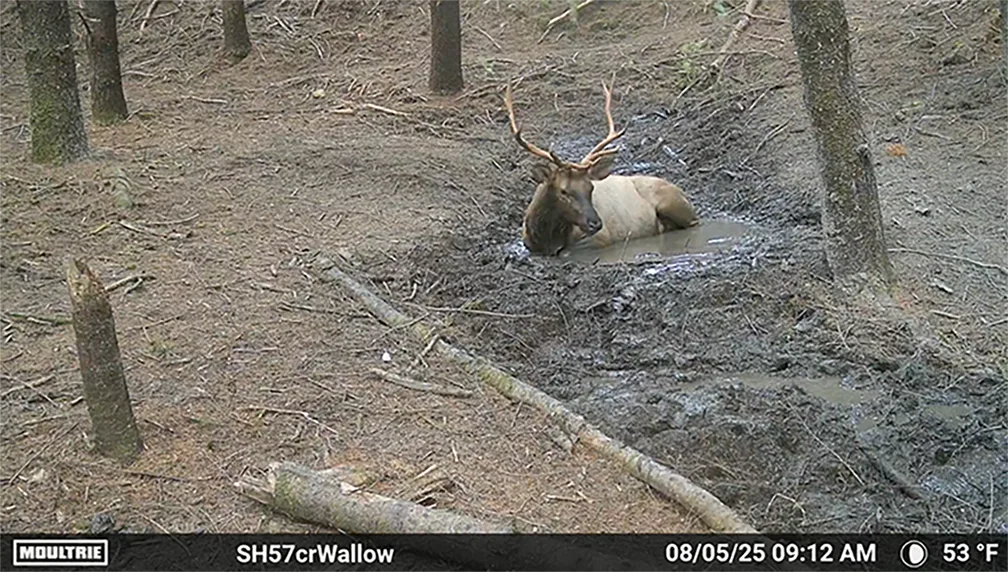
Look for Mud on Trees
When reading tracks and trails, look at the bases of trees to see where bulls have rubbed their bodies after leaving a wallow. These aren’t raking rubs, they’re scratching rubs. Study the trees closely to make sure they’re not from bears rubbing on them. The number of bears that use elk wallows might surprise you, which is even more reason to closely inspect a wallow, tracks, and muddied trees. I’ve caught multiple bears using elk wallows several days in a row, and not a single elk. From a distance, the wallow looks fresh with elk activity, but it’s actually bears.
The rubbing of muddy, wet bodies on trees by bulls happens most commonly near wallows, but sometimes continues along a trail. The sign will confirm the direction being traveled after a bull has wallowed. Often, these muddy trees lead to rubs.
What Rubs Tell You
Rubs are another valuable piece of information elk hunters will want to study closely. The progression of elk rubs starts with the stripping of velvet in early to mid-August. As soon as the velvet is stripped, testosterone levels begin to spike, and this marks the start of the pre-rut. With the primary rut only a couple of weeks away, the number of elk rubs quickly multiplies.
I’ve seen bulls make rubs from mid-August through September and into mid-October in multiple Rocky Mountain states. I’m embarrassed to admit the number of times I misread rubs from a distance, early in my hunting career. Now, when I see a rub I inspect it closely–touching and smelling it–before drawing any conclusions from it. Here are three things to consider when you come across an elk rub.
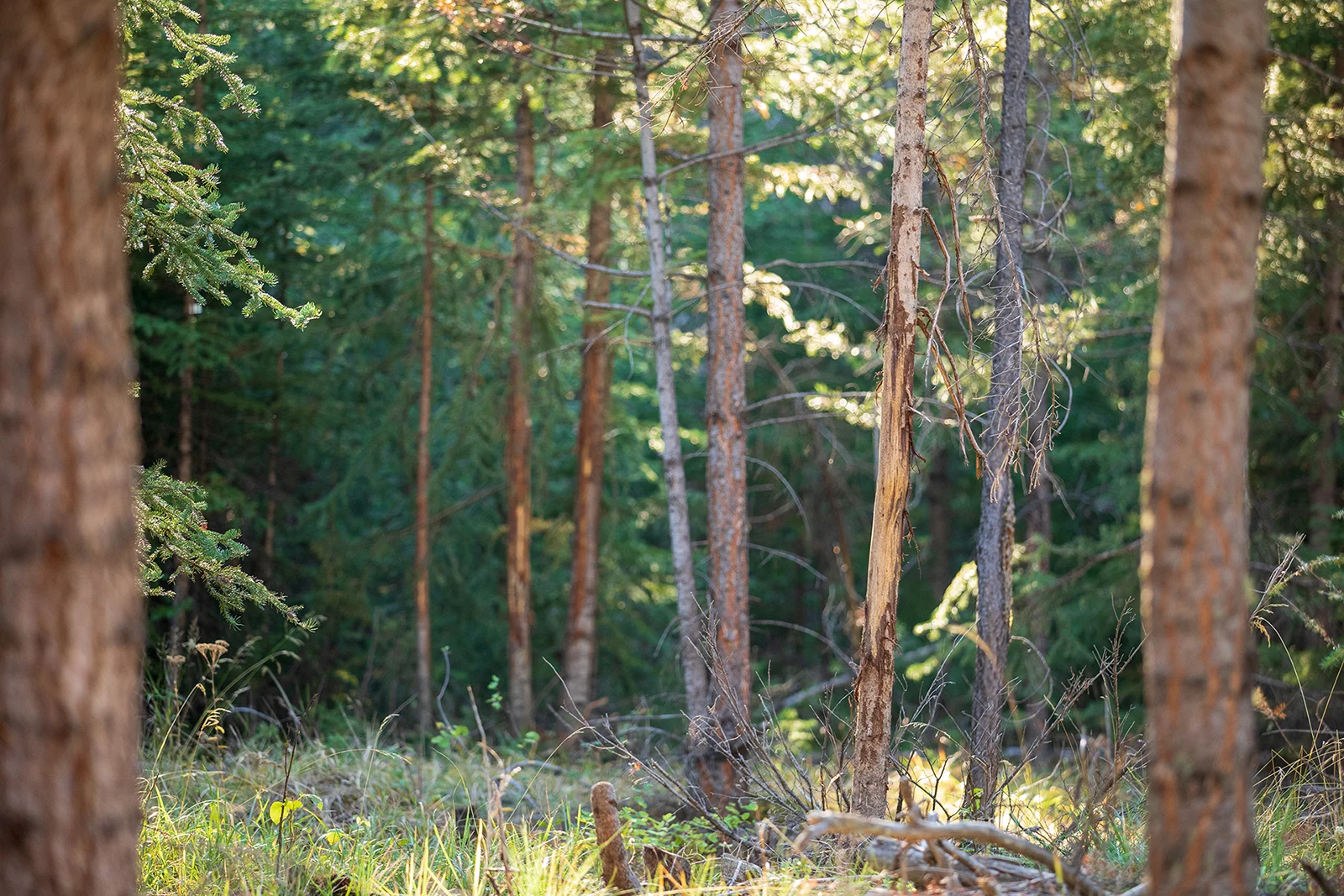
Curly or Flat?
If bark that’s been stripped from a tree–or shredded and still hanging on the tree–is still wet on the edges and lies flat, you’re looking at a fresh rub. If sap seeping from tree wounds has not yet hardened, you’re looking at a fresh rub. This spot is worth hunting, now.
If the strips of bark have hardened and the edges have begun to curl, you’re looking at an older rub. The same is true if the sap has hardened. Even from a few feet away, these rubs can be misleading, looking fresh when they’re actually not. The sap looks wet, the exposed cambium layer appears white, and the strips of bark seem moist. But look closely because you don’t want to waste time hunting an area where bulls passed through a week prior.
Temperature, sun, and wind exposure can age a rub at varying rates, as can the thickness of the strips of bark themselves. It’s not always a constant. It can vary from place to place and week to week, so examine them closely.
Rub Lines & History
Next, look for rub frequencies. The more fresh rubs that occupy an area, the longer a bull has lingered there. Multiple bulls will also make rubs in the same area, sometimes when they’re simply passing through. Often, a herd bull makes the initial rubs, then subordinate bulls move in, or vice versa.
Once fresh rubs are located, look for old rubs. Rubs made two, three, even five or six years prior indicate bulls have been using this area during the rut for consecutive years. Something with that habitat is holding constant, keeping cows, calves, and bulls in the area. They may not be there in the summer or after the rut, but during the peak rut, favorable conditions exist. These are places to hunt. Some places I hunt have been used by bulls for over 15 years, and they’re only there during the rut.
Conversely, I’ve seen many fresh rub lines that lead to a dead end. This is where a bull thrashes a series of trees all at once, likely while the harem is feeding or bedded down. Sometimes a hormone-induced bull will rake trees in an outrage to get a cow that’s nearing estrus to stand. Once the herd leaves this area, they may not be back for a week or more, if at all. The crests of ridges and the sidehills of wooded mountains are where I’ve seen most of these ghost rub lines.
One September in Wyoming’s wilderness, just shy of the 10,000-foot mark, two buddies and I ran across a series of more than 30 fresh rubs atop a ridgeline. We hunted the flats on top, but all the elk were in the bottom of the canyons, on each side. We arrowed two nice bulls later that day, and another the following morning. While the rub line was nearly two miles from where we killed the bulls, it tipped us off to where they were.
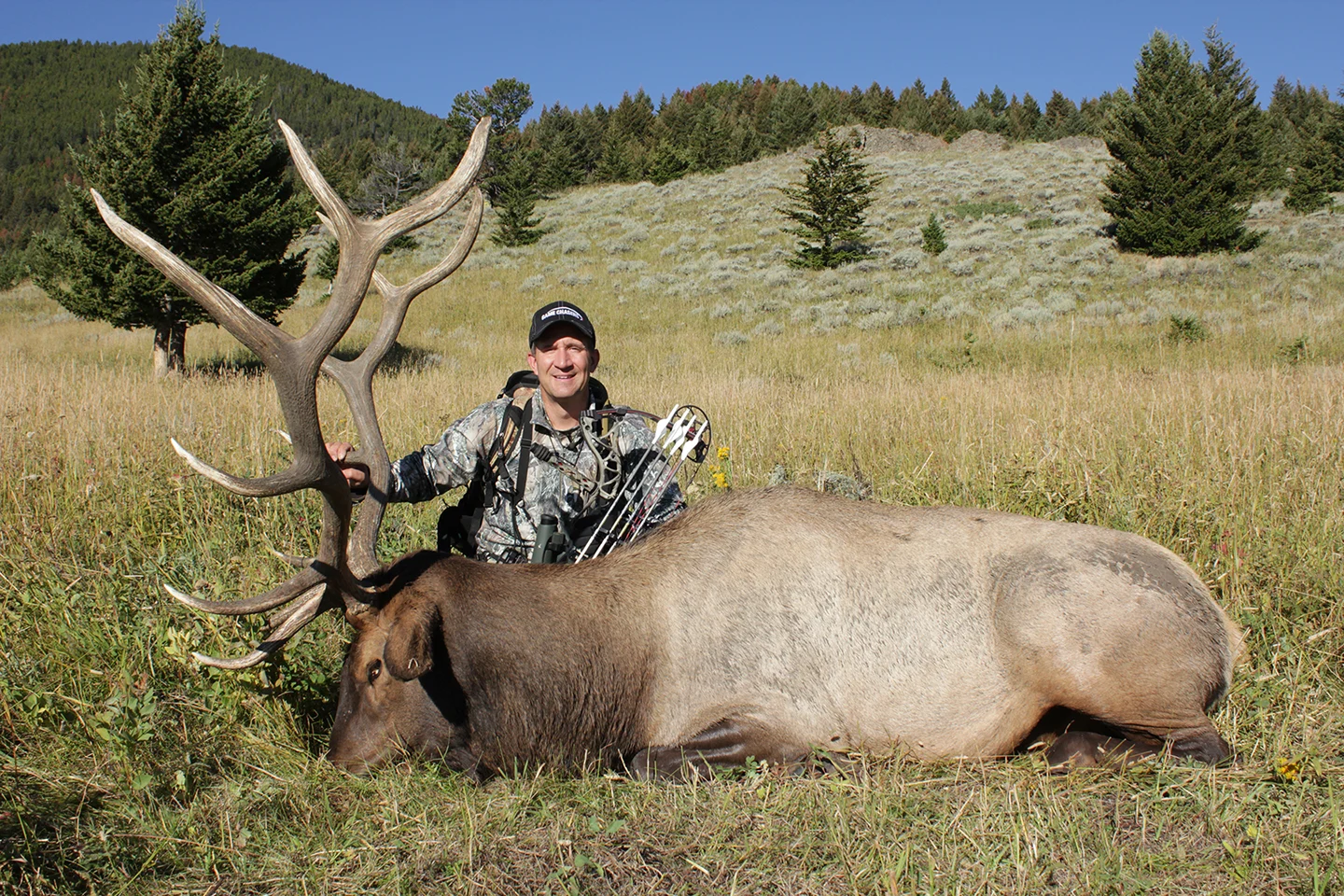
Connect the Dots
Rubs and wallows are sometimes separated by great distances. Rubs can be made on a whim, on any tree, any time a bull feels a surge of adrenaline. Wallows are intentionally visited. With the obvious extension of hot days into fall, the number of wallows that dry up by late September has increased in recent years. This is when bulls go to raking small patches of brush and wallowing on dry ground. Often, they urinate and roll in it amid open, hard ground. Dust and yellow grass go flying when dry wallowing occurs. I’ve seen dry wallows in sage brush, too, along with raking the stiff little bushes.
Wallows and rubs are a gauge of the elk rut. They’re also measures of testosterone levels in bull elk, be it a herd bull or insubordinate bulls. They can reveal how a bull is interacting with a harem, how the harem is behaving, and even how bulls are engaging with one another.
Though I’ve never killed a bull in a wallow, or while it was raking tree, both sources have provided invaluable insight that’s helped me close the deal around and between them, many times. This season, do more than glance at rubs and wallows. Study them closely and decipher all the information they contain. Doing so will take your understanding of elk and how to hunt them to a whole new level.

